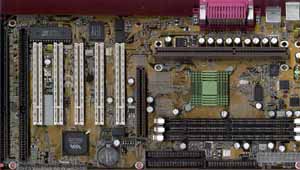VIA Apollo Pro 133/133A Motherboard Roundup - February 2000
by Anand Lal Shimpi on February 28, 2000 1:13 AM EST- Posted in
- Motherboards
|
Motherboard Specifications |
|
| CPU Interface |
FC-PGA Socket-370
|
| Chipset |
VIA Apollo 133A
VIA 694X North Bridge VIA 596B South Bridge |
| L2 Cache |
N/A (on-chip)
|
| Form Factor |
ATX
|
| Bus Speeds |
66
/ 75 / 83
100 / 112 / 124 133 / 142 / 152 |
| Voltages Supported |
Auto Detect - 1.30v - 3.5v
|
| Memory Slots |
3 168-pin DIMM Slots
|
| Expansion Slots |
0 AMR Slots
1 AGP Slot 5 PCI Slots (2 Full Length) 2 ISA Slots (2 Full Length) |
| AC'97 |
N/A
|
| BIOS |
AWARD BIOS 6.00PG
|
Shuttle’s AV64 is the smallest ATX board in this roundup. While that’s not a major advantage for Shuttle it does help reduce the cost of the board a bit and also pave the way for an even smaller microATX version. The board is a full inch shorter than the ASIS P3V4X in terms of its depth.
The biggest compliant we had with the AV64 was that the CPU setup and configuration of the board was classic Shuttle, meaning it wasn’t nearly as straightforward as it could have been. Shuttle uses their own hybrid jumper/jumperless setup that ends up confusing the user more than helping them with more options. We would have preferred it if Shuttle went with something like ASUS’ JumperFree setup where 100% of the configuration is done within the BIOS with a single block of dip-switches placed in an easy to reach area if you wish to override the jumperless configuration. Instead, Shuttle uses a combination of jumper blocks scattered on various parts of the motherboard that honestly requires more work to lay out than it does to simply include a normal jumperless setup.
One of the jumper blocks can be set to auto allowing the user to pick the settings in the BIOS; however, that jumper block controls the clock multiplier and not the FSB frequency. And since all Intel CPUs are clock multiplier locked, this feature is useless.
If you can get past that annoying little fact that has been with Shuttle for a couple years now, the AV64 actually has just about everything you could ask for in a 133A board with the exception of a 686A Super South Bridge (it uses the older 596B).
The board features manual voltage adjustments, an average set of FSB frequencies to choose from, and was pretty stable in our tests. While it wasn’t as stable as the Gigabyte or ASUS boards, it was definitely up there in terms of stability and it’s performance wasn’t anything to complain about either.
Overall the board isn’t too bad, a tad annoying, but it’s definitely a better option than some of the other boards that made it into this roundup.











0 Comments
View All Comments